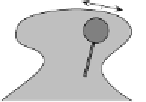Geology Reference
In-Depth Information
(a)
(b)
(c)
Figure 8.1. Sketch of the generation of plumes in the broad zone of upward mantle
return flow between subduction zones. Dark grey: hot thermal boundary layer and
plumes; light grey: warm zone. The deep converging flow thickens the bottom
thermal boundary layer, which increases its instability and its propensity to gen-
erate plumes. Such a sequence might account for the burst of plume formation in
the Pacific region during the Cretaceous. After Davies and Pribac [91]. Copyright
by the American Geophysical Union.
with the arrival of plume heads, sometimes with a time delay [92]. The delays
may be due to the lithosphere needing to be weakened by heat conducting up from
the plume head. Examples are the jump of rifting from the west to the east of
Greenland, the openings of the central Atlantic and the South Atlantic, and rifting
of India's west coast. Not all plume head arrivals resulted in rifting, as the examples
of the Columbia River Basalts and the Siberian flood basalts testify.
Thus the main effect of plumes on the plate mode seems to be to occasionally
trigger the break-up of a plate. The mechanism is probably the uplift by several
hundred metres caused by the plume head [93], which would generate a gravity
sliding force.
8.2 Common misconceptions
Many ideas were proposed in the early days of plate tectonics in attempts to
understand this unfamiliar phenomenon. A few of those ideas have survived and
form the basis of the previous chapters. Other ideas have been superseded or shown
to be incorrect. However, some of the latter ideas still persist, presumably because
the modern understanding of mantle convection is not as widely known as it might
be. Some of the more common misconceptions will be noted here.
8.2.1 Plumes are not the return mode of plate flow
We noted this in the previous section. Plumes are active components of convection
driven by a bottom thermal boundary layer. They could exist even if there were no
plate tectonics.
8.2.2 There is normally no active upwelling under mid-ocean ridges
In the account given in Chapter 6, the plate mode of convection is driven by the
negative buoyancy of subducted lithosphere. The idea of an additional, positive












